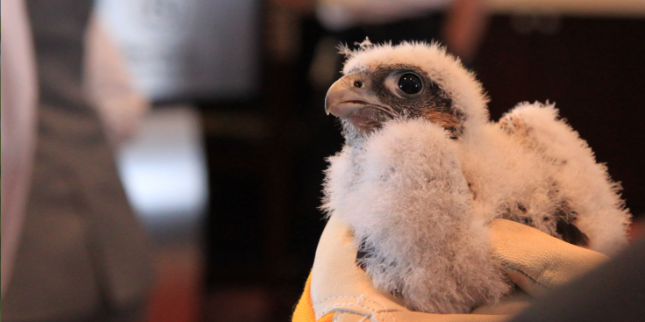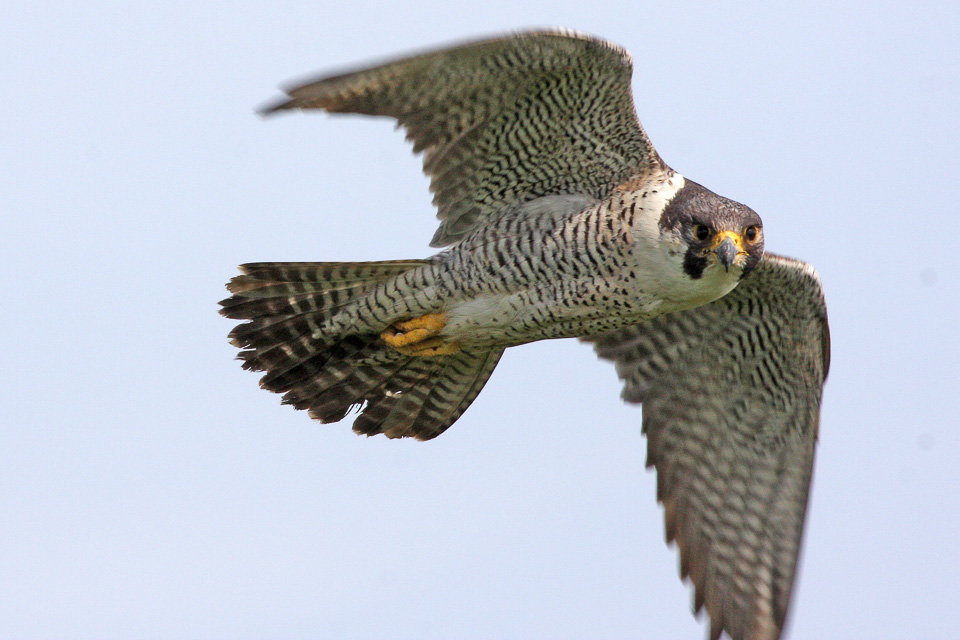Like this article? rabble is reader-supported journalism. Chip in to keep stories like these coming.
It’s sleek. It’s black. It’s approximately the size of a crow.
It’s also the fastest animal on earth.
Reaching over 320 kilometres per hour during its characteristic high-speed dive, the peregrine falcon is one of nature’s most awe-inspiring predators. Once an isolated cliff-dwelling hunter, these birds are now a high-flying slice of the natural world visible right outside our condos and skyscrapers.
But 50 years ago, Canadian peregrine falcons were on the ropes. Once-common, their numbers had plummeted as a result of widespread DDT use, a pesticide linked to both bird and human deaths. In the span of 10 years, it disappeared entirely from Ontario. It only began to creep back, bird by bird, in 1990.
Now, they’re thriving. Ontario has more than 90 breeding pairs, and a 2012 report by the North American Bird Conservation Initiative named raptors, of which peregrine falcons are members, as the fastest-growing group of Canadian birds. In contrast, some of the most common birds on the planet, like songbirds, grassland birds, and insect eaters, have been experiencing massive declines.
In light of the peregrines’ success, a decades-long recovery initiative has been dismantled — and with good reason, says Ted Armstrong, a wildlife biologist who spent decades with the falcons at the Ontario Ministry of Natural Resources.
“We’re now at the stage where they’re producing more young every year than we released at the peak of the national release program. So there’s no need for a release program now. I think virtually every bird will be a wild-reared bird.”
So why are the falcons thriving?
Country bird and city bird
According to Gordon Court, a wildlife biologist with the Province of Alberta, it’s their ability to flourish in the ever-growing urban landscape. He says the peregrine’s adaptability has earned it a nickname — the avian weed.
“It’s the most beautiful bird you can possibly imagine and the fastest thing that’s lived on the planet, but it’s also been described as an avian weed that has been able to colonize all sorts of environments, including the urban environment, across the world,” he says. “And that’s because all they needed was to be given a chance to live without DDT around every corner.”
But the population rebound didn’t come without some changes. Unlike their pre-DDT ancestors, Armstrong says today’s falcons are playing “country mouse and city mouse.”
“What we had in Ontario was this fascinating thing where the city populations started to grow, and the cliff nesting population in the northern end [of Ontario] started to grow,” he says. “So we end up having these two solitudes, where we have the two different populations kind of doing their thing with very little crossover between them.”
The divide is reflected across Canada, with few exceptions. According to a 2012 report in the Journal of Canadian Wildlife Biology and Management titled “Lessons learned during the recovery of the Peregrine Falcon in Canada,” Ontario has seen only two documented crossovers between groups.
Though the difference between secluded countryside nesting and urban living appears extreme, the peregrines’ preferred habitat is similar — rural birds nest on secluded cliff sides, and urban peregrines prefer high ledges on tall buildings.
According to the report, many of the birds have chosen the city lifestyle.
“The lesson learned was that in the end, the peregrine falcons decided where they wanted to nest,” it alleges. “Despite targeting mass hacks (releases) at rural sites, the falcons have chosen to move into urban settings and adopt human-made structures as nesting sites in many parts of southern Canada.”
The advantages of urban living are numerous. Urban falcons tend to have larger broods and nest earlier. Urban chicks also have a better chance of surviving to adulthood, thanks to a lack of predators. But city real estate can be hard to come by, and competition is fierce.
“If a bird of an active breeding pair perishes, whether it’s male or female, it’s often replaced right away,” Armstrong says. “So there are definitely floater birds out there, and if there’s an opening they’ll slip in. And sometimes there are three way battles — you know, between two males and a female or two females and a male.”

A peregrine hatchling being banded at the Toronto Sheraton Centre. (Photo: Matt MacGillivray, Flickr)
All you can eat living
Mark Nash, co-founder and executive director of the Canadian Peregrine Falcon Federation, says pigeons, sparrows, grackles, chickadees, and other urban residents comprise a readily available food source that’s bolstered the falcons’ numbers both at home and across the globe.
“These resident bird populations, they don’t migrate anymore. They can be found in one area or another of our cities 365 days of the year, seven days a week, every day all day. It’s made it possible for our urban adult falcons not to have to migrate. In part, the successes for the urban peregrines have been a result of the abundance of that urban avian population that never seems to go away.”
John Cooper is a wildlife biologist who penned a 2007 report on the peregrines for the Committee on the Status of Endangered Wildlife in Canada. He says despite the ideal conditions, it’s unlikely the birds will become a common sight in cities.
“They are territorial birds and there’s so many you can pack into a certain square. So that area can be smaller or larger depending on the food source — if there’s lots of food, you can pack them a little denser. But it’s not like you’ll have them nesting side by side on one building or one block even.”
If it’s true that a new urban lifestyle is the key to the peregrine’s success, they’re not alone. Mike Runtz, a wildlife biologist and instructor at Carleton University, says other raptors have learned to capitalize on the benefits of urban living.
“A lot of the raptor populations that have increased, cooper’s hawks, sharp-shinned hawks, in particular, are urban nesting birds now,” he says. “But others are still declining — northern goshawks for example have not increased. But they are more reclusive birds of prey that do not handle urbanization at all.”
But for these resilient fliers, there is turbulence ahead.
The pesticide debate
The falcons’ recovery hinged on the disuse of DDT. Now, there might be a new chemical threat. Nicotine-based pesticides, termed neonicotinoids, are worrying avian biologists. They’ve been used in Ontario since the mid-1990s, and have already been linked to drastic declines in insect populations.
“These are systemic threats like organichlorine pesticides were,” says Court. “I’m concerned that it’s more than the pollinators, it’s the systemic collapse of the insect biomass that’s available there for all insectivorous birds, including things like the American kestrel, the small cousin of the peregrine.”
As strict connoisseurs of small birds, peregrines depend on insect populations to sustain their prey. When the insect eating birds are starved out, the rest of the ecosystem follows. But food chain collapse isn’t the only problem — there’s some concern the toxins will accumulate in birds as they move up the food chain, just like DDT did.
“It’s frightening to think we have a new DDT on the market,” says Runtz. “It wasn’t thought to be persistent and now it is, and the effects seem to be much more rapid I think than they were with DDT. It seems to be a much deadlier chemical and that’s a big concern right now. And who knows what the long term effect will be?”
According to Gregor beck, a biologist at Bird Studies Canada, if the toxins are having adverse effects on wildlife, the peregrines are likely the species to watch.
“They literally can be canaries in the coal mines, as far as telling you the state of the environment.” He says. “There are always going to be changes, and we need to keep up on those. People sometimes think everything’s been fixed, and then all of a sudden there are other issues to be looking out for.”
In 2013, the European Union banned the pesticides, citing environmental and human health concerns. In July 2015, the Ontario government became the first in North American to curb their use, legislating restrictions on their application. By 2017, Ontario aims to reduce the amount of corn and soybean farmland treated with neonicotanoids by 80 per cent. But for most of Canada, the chemicals are still widely used.
“This is just exactly what we did with pesticides like DDT,” says Court. “A combination of ignorance and human greed — we started to use this stuff everywhere, on everything. We painted the world with DDT and we paid the price for it. Peregrines just about paid with their very existence.”

Jen Halsall is studying journalism and history at Carleton University in Ottawa. She is a passionate environmentalist with a penchant for science reporting and a soft spot for “all that is green and good.” You can find her on twitter as @Jennhalsall. She is rabble’s 2015-16 blogs intern.
Like this article? rabble is reader-supported journalism. Chip in to keep stories like these coming.



